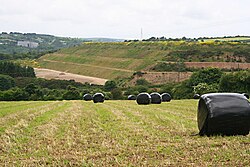Tailings Dam
A tailings dam is typically an earth-fill embankment dam used to store byproducts of mining operations after separating the ore from the gangue.
Tailings can be liquid, solid, or a slurry of fine particles, and are usually highly toxic and potentially radioactive. Solid tailings are often used as part of the structure itself.

Tailings dams rank among the largest engineered structures on earth. The Syncrude Mildred Lake Tailings Dyke in Alberta, Canada, is an embankment dam about 18 kilometres (11 mi) long and from 40 to 88 metres (131 to 289 ft) high. The dam and the artificial lake within it are constructed and maintained as part of ongoing operations by Syncrude in extracting oil from the Athabasca oil sands; it is the largest dam structure on earth by volume, and as of 2001 it was believed to be the largest earth structure in the world by volume of fill.
There are key differences between tailings dams and the more familiar hydroelectric dams. Tailings dams are designed for permanent containment, meaning they are intended to "remain there forever". Copper, gold, uranium and other mining operations produce varied kinds of waste, much of it toxic, which pose varied challenges for long-term containment.
An estimated 3,500 active tailings impoundments stand around the world, although there is no complete inventory, and the total number is disputed. In an average year, it would be expected that between 2 and 5 "major" tailings dam failures would occur, along with 35 "minor" failures. Assuming the 3,500 figure is correct, this failure rate is "more than two orders of magnitude higher than the failure rate of conventional water retention dams". A 2020 assessment of responsible mining practices by the Responsible Mining Foundation, found that companies have made little or no progress in improving the documentation and safety practices of these ponds.
Structure

Unlike water retention dams, the height of a tailings dam is typically increased (raised) throughout the life of the particular mine. Typically, a base or starter dam is constructed, and as it fills with a mixture of tailings and water, it is raised. Material used to raise the dam can include the tailings (if their properties are suitable), earthfill, or rockfill. It is increasingly common for barrier systems such as geomembranes to be incorporated into tailings dams. Impermeable barriers can prevent or reduce seepage thereby increasing the geotechnical and environmental stability of the dam.

There are three types of dam raises, the upstream, downstream and centerline, named according to the relative position of the new crest of the dam to the previous. The specific design used is dependent upon topography, geology, climate, the type of tailings, and cost. An upstream tailings dam consists of trapezoidal embankments being constructed on top but toe to crest of another, moving the crest further upstream. This creates a relatively flat downstream side and a jagged upstream side which is supported by tailings slurry in the impoundment. The downstream design refers to the successive raising of the embankment that positions the fill and crest further downstream. A centerlined dam has sequential embankment dams constructed directly on top of another while fill is placed on the downstream side for support and slurry supports the upstream side.
Largest
The largest three tailings dams are:
| Rank | Name | Country | Year completed | Structure height [m] | Structure volume [106 m3] | Reservoir volume [109 m3] | Installed capacity [MW] | Type |
|---|---|---|---|---|---|---|---|---|
| 1 | Syncrude Tailings Dam Mildred MLSB |  Canada Canada | 1995 | 88 | 540/720 | 0.35 | NA | TE |
| 2 | Syncrude Tailings Dam Mildred SWSS |  Canada Canada | 2010 | 40–50 | 119 | 0.25 | NA | TE |
| 3 | ASARCO Mission Mine Tailings Dam |  United States United States | 1973 | 30 | 40.1 | 0 | NA | ER |
Type: TE – Earth; ER – Rock-fill; PG – Concrete gravity; CFRD – Concrete face rock fill
Concerns

See also
References
This article uses material from the Wikipedia English article Tailings dam, which is released under the Creative Commons Attribution-ShareAlike 3.0 license ("CC BY-SA 3.0"); additional terms may apply (view authors). Content is available under CC BY-SA 4.0 unless otherwise noted. Images, videos and audio are available under their respective licenses.
®Wikipedia is a registered trademark of the Wiki Foundation, Inc. Wiki English (DUHOCTRUNGQUOC.VN) is an independent company and has no affiliation with Wiki Foundation.